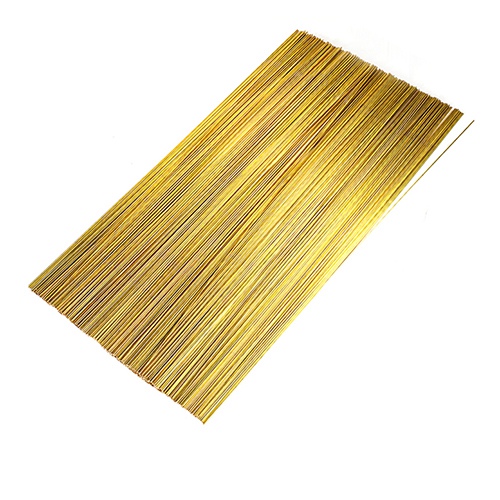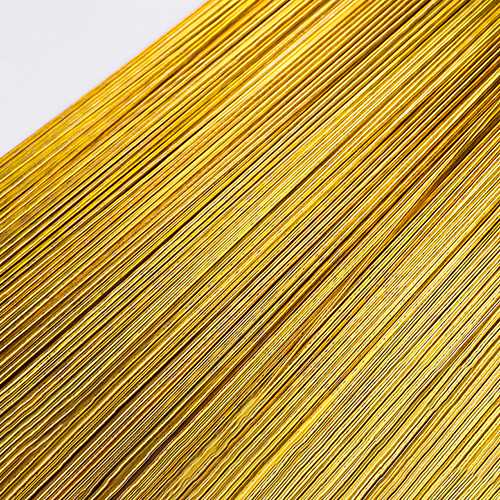Brass welding rod for brazing at low temperature is a specialized welding material with the advantage of lower melting point. These Low Temp brass brazing rods consist of an accurate combination of zinc and copper that have good flow properties even at lower temperatures, thus ensuring a firm and strong bond. Copper-phosphorus solder includes copper and zinc based solders, which have good liquidity and are suitable for contact brazing, flame brazing, high-frequency brazing or furnace brazing. It enhances the wettability of the solder., increase strength & ductility, reduce melting point. The main application of copper-zinc solders is in flame, high frequency resistance and other types of brazing techniques..

| BrazingAlloys | AWS | Chemical Composition(%) | Solidus | Liquidus | Main Uses | |||||||
| Ag | Cu | Zn | Sn | Si | Other | F | ℃ | F | ℃ | |||
| BCu | BCu-1 | / | 100 | / | / | / | / | 1981 | 1082 | 1981 | 1082 | Suitable for furnace brazing of steel, stainless steel and nickel-based alloys. |
| BCu58Zn | / | / | 58 | / | 38 | / | Mn:4 | 1616 | 880 | 1668 | 909 | Mainly used for brazing of hard alloy cutter. |
| BCu60Zn | / | / | 60 | / | 39 | 1 | Si:0.25 | 1634 | 890 | 1661 | 905 | Mainly used for brazing ferrous metals, nickel-based alloys and Cu-Ni alloys; it has good fluidity. |
| BCu58ZnFe | BCuZn-C | / | 58 | / | 40.2 | 1 | Fe:0.8 | 1670 | 910 | 1749 | 954 | |
| BCu48ZnNi | BCuZn-D | / | 48 | / | 41.8 | / | Ni:1 Si:0.2 | 1720 | 938 | 1799 | 982 | |

Brass solder has a wide range of applications and is commonly used in ordinary flame welding. It is mainly used in refrigeration, air conditioning, plumbing and electrical industries. We can produce all kinds of formulas, and can also cooperate with R&D and customization to reduce costs and increase efficiency for your production. Specifically Please contact the technical department if required.

Durable and Strong Joints: The use of metal welding rods forms strong, durable joints on different pieces of metals. These joints help in providing structural stability and integrity to the respective welded assemblies. The welded joints are mechanical forces, vibrations, and environmental stresses resistant hence guaranteeing long-term performance.
Versatility: Metal welding rods are available in a range of types and compositions to suit various welding applications and metal materials. Various common types include mild steel, stainless steel, aluminum, cast iron as well as specialty alloys each designed for specific welding jobs and type of metals. Such versatility consequently allows welders to select the best rod for their projects.
Ease of Use: Metal welding rods are relatively easy to use thus making them useful for both experienced welders and beginners. They can also be used with different types of welding such as shielded metal arc welding (SMAW), gas metal arc welding (GMAW) or gas tungsten arc welding (GTAW). Welder’s rods come in various diameters plus lengths enabling precise control over the process while manipulating it.
Welding in Different Positions: Metal welding rods enable high-quality welds from flat positions up to overhead through horizontal, vertical & even out-of-position wielding. This flexibility helps the workers’ carry out various tasks associated with fusion under challenging conditions such as being in cramped spaces.
A Cost-Effective Approach: Generally speaking, metallic wielder’s sticks tend to be affordable compared to other consumables or equipment used during this process. They are readily available within the market at pocket-friendly prices hence ensuring they become an economical option when it comes to its operations related to a number of repair situations as well as fabrication projects.
Superior Weld Quality: When properly employed metallic wielder’s sticks can give highly superior welds that have good penetration depths along with neatly rounded convex surfaces along which beads lie on top. Furthermore, correct ways & processes like appropriate angle measurement ensure that welded joints remain within the ambit of high standards set for industry concerning the levels of firmness as well as beauty of their appearances.
Ease of Adaptation to Different Metals: Welding rods made out of metal can be used to join various metals and alloys including, but not limited to carbon steel, stainless steel, aluminum, copper, brass and titanium. This makes it possible for welders to operate on different materials in order to deliver consistent quality and performance welds.
Welding in Different Ambiances: Metal welding rods are suitable for use in a range of environments such as indoor workshops, outdoor construction sites or industrial facilities. They are thus able to withstand variations in humidity, temperature changes as well as atmospheric conditions making them quite effective regardless of working conditions involved.

Brass brazing rods are mainly used for brazing of brass and other copper alloys, and can also be used for brazing of certain stainless steels, nickel alloys and carbon steels.
Brazing rod diameter selection depends on the size of the joint and the amount of filler required. Smaller joints are suitable for thinner brazing rods, while larger joints require thicker brazing rods.
Brass brazing can use heat sources such as flames, soldering irons, and induction heating. The heat source should be selected to ensure that the brazing temperature reaches the melting point of the brazing material while avoiding excessive thermal effects on the base metal.
Before brazing, the joint surface needs to be cleaned to remove oil, oxides and other impurities. Sometimes it is also necessary to apply flux on the joint surface to promote wetting and flow of the brazing material.
When brazing brass, attention needs to be paid to controlling the heating speed and temperature to avoid overheating of the base metal or loss of brazing material. At the same time, ensure that the brazing material is fully wetted and fills the joint gaps to form a uniform weld.
The inspection of brass brazed joints usually includes visual inspection, sealing test and mechanical performance test. The appearance inspection mainly observes whether the weld is flat and continuous, without defects such as cracks and pores; the sealing test can be carried out through air pressure or water pressure tests; the mechanical performance test includes tensile, bending and other tests to evaluate the strength and toughness of the joint.
Brass brazing rods should be stored in a dry, ventilated place to avoid moisture and contamination. Brazing rods that have not been used for a long time should be inspected before use to ensure that there are no rust, oil stains and other impurities on the surface.